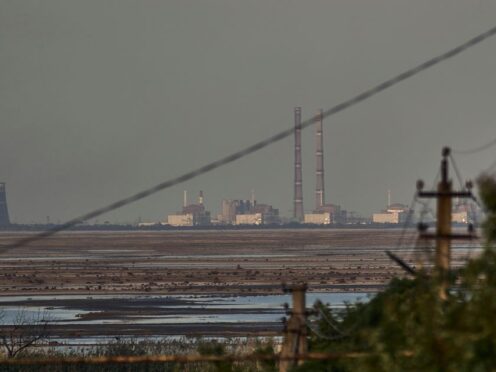
The head of the UN’s nuclear watchdog has visited Russia amid concern about a Ukrainian power plant caught in the crossfire since Moscow sent troops into Ukraine in 2022 and seized the facility.
International Atomic Energy Agency (IAEA) director-general Rafael Mariano Grossi arrived at the Black Sea resort of Sochi on Tuesday evening, according to Russian state news agency RIA Novosti.
Mr Grossi announced the trip on Monday, the first day of a regular meeting of the agency’s 35-nation board of governors in Vienna.

The IAEA has repeatedly expressed alarm about the Zaporizhzhia Nuclear Power Plant, Europe’s largest, amid fears of a potential nuclear catastrophe.
The plant’s six reactors have been shut down for months but it still needs power and qualified staff to operate crucial cooling systems and other safety features.
Speaking to reporters in Sochi on Wednesday, the IAEA chief said he had a “very intensive and exhaustive working session” with Russian officials, including from Russia’s state nuclear energy agency Rosatom and the foreign and defence ministries.
“This gave me, and gave us, I think, an opportunity to evaluate the situation at the nuclear power plant,” he said.
Mr Grossi later met Russian President Vladimir Putin and said on X, formerly Twitter, that they had an “important exchange” about the plant and nuclear non-proliferation issues.
Important exchange with the President of the Russian Federation Vladimir Putin in Sochi, on the nuclear safety and security of #ZNPP and other non-proliferation global challenges. pic.twitter.com/1eHEVks1iq
— Rafael MarianoGrossi (@rafaelmgrossi) March 6, 2024
The IAEA chief last met Mr Putin in October 2022.
He visited Ukraine in February and crossed the front line to visit the Russian-held plant as part of the IAEA’s efforts to prevent a nuclear disaster amid ongoing hostilities. He also held a meeting with Ukrainian President Volodymyr Zelensky.
Before heading to Russia, Mr Grossi told reporters in Vienna that he considered it important to maintain a dialogue with both sides and added that the situation with the Zaporizhzhia plant “continues to be very fragile”.
He said that he expected to discuss “technical issues” related to “the future operational status of the plant” in Moscow.
He also said if the plant is to be restarted, he would need to discuss “what kind of safety evaluation” would be needed and that he planned to discuss the issue of external power supply lines.
The plant has suffered eight losses of off-site power since the seizure, forcing it to rely on emergency diesel generators temporarily, and it continues to face challenges related to staffing.
Ukraine’s Energoatom, which operates all of the country’s nuclear power plants, has repeatedly said Russia restricted qualified Ukrainian staff from accessing the Zaporizhzhia plant after they refused to take Russian citizenship and to sign a contract with Rosatom.
Nearly 5,200 workers have left the plant since Russia took over in March 2022, according to Petro Kotin, Energoatom’s acting board chairman.
Mr Kotin said in a statement on Tuesday that at the beginning of the year, 360 Ukrainian employees — who did not have contracts with Rosatom — were still working at the plant but starting in February they could not access the facility any more.
Mr Kotin said Ukrainian staff were replaced with Russian workers or residents of Russian-controlled cities and towns nearby “who do not understand what a nuclear power plant is”.

Enjoy the convenience of having The Sunday Post delivered as a digital ePaper straight to your smartphone, tablet or computer.
Subscribe for only £5.49 a month and enjoy all the benefits of the printed paper as a digital replica.
Subscribe